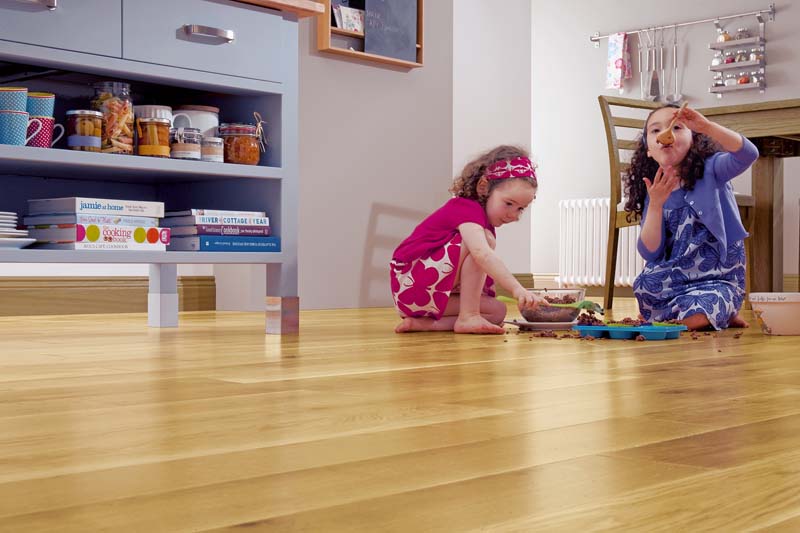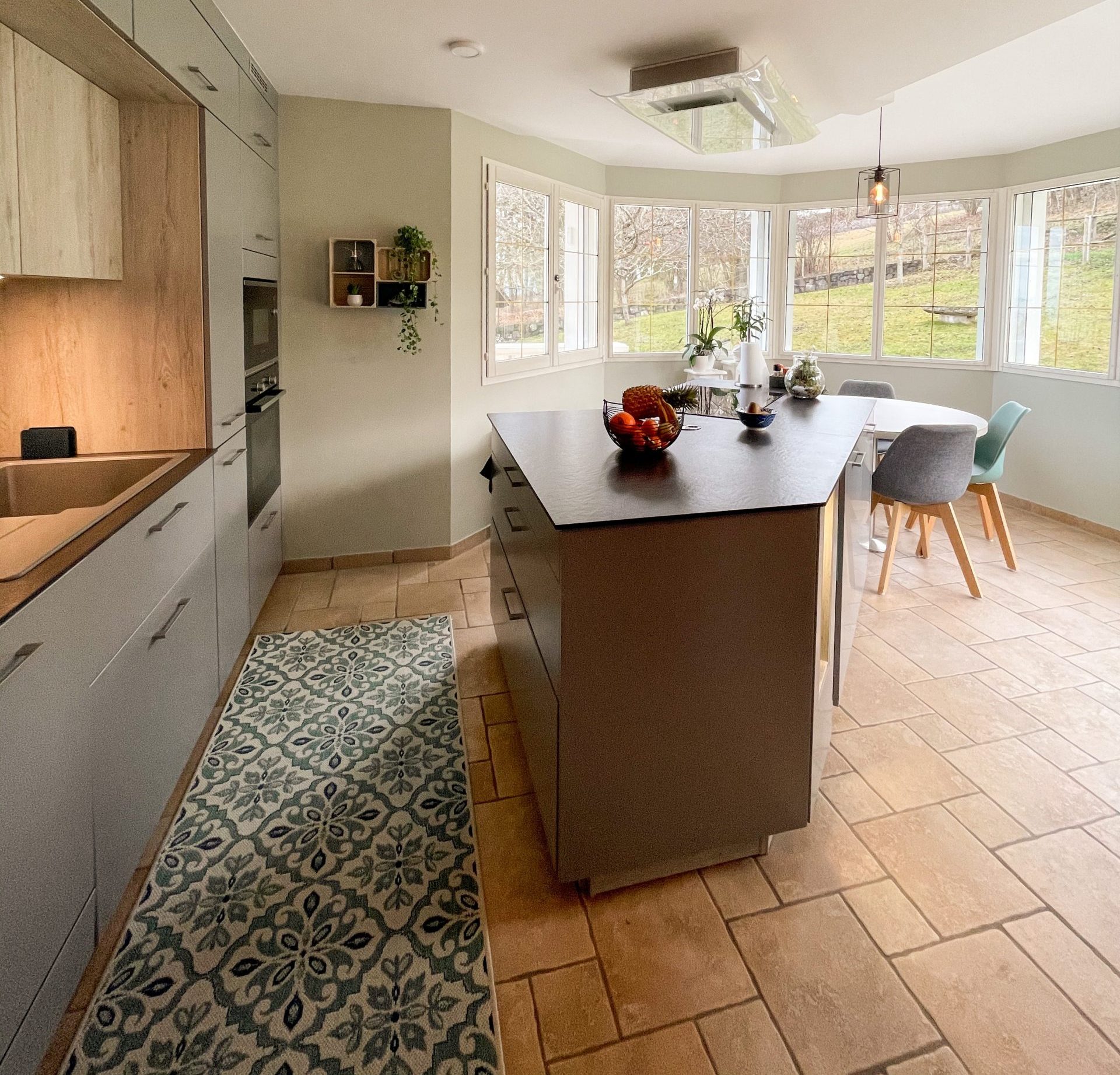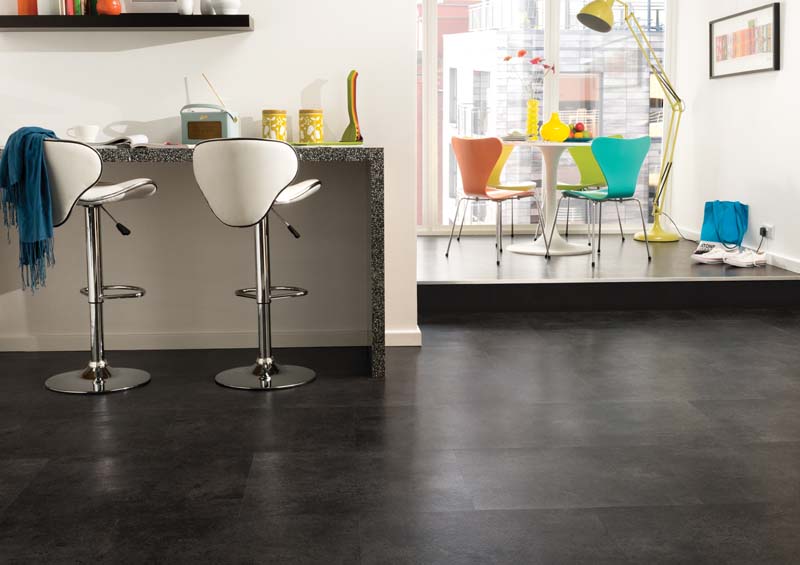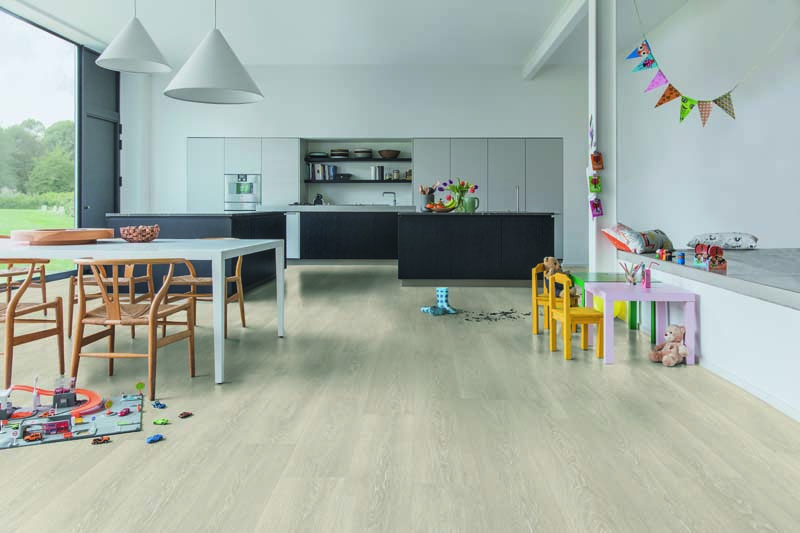25 January 2022
Our top 5 guide to the best kitchen flooring
Did you know there are thousands of options available for kitchen flooring? Head to any flooring showroom, website or catalogue, and you’ll be spoilt for choice. Row upon row, tile after tile, vinyl after vinyl, in just about every colour, finish, style, shape and size you can imagine – it’s enough to overwhelm anyone.
From luxury vinyl tiles to genuine hardwood planks, and porcelain to parquet, there are multiple materials to consider. So before rushing into a decision, take some time to think about what you need from your flooring.
If your new flooring is for the main kitchen in your home, where multiple family members cook, eat, snack and pass through, you’ll probably want something long-lasting and hardwearing.
Kitchens with a lot of use are subject to steam, cooking fumes and spillages, so you’ll want a floor that won’t crack or chip the second a saucepan is dropped on it.
Then again, your new floor could be for an annexe or second dwelling, only used for preparing the occasional meal or unpacking takeaway boxes. In this case, getting the right look might be more important than getting something easy to maintain.
Or maybe you’re a property investor in need of flooring for a buy to let or buy to flip. In these cases, you might be more concerned about keeping costs down.
Understanding how your kitchen will be used can help you decide which type of floor will work best.
Laminate flooring
Laminate flooring is the ideal choice for cost-conscious buyers. It’s a market staple and a popular kitchen flooring choice for all sorts of reasons, not just because of its affordability.
Both laminate and vinyl have come a long way since their early years. And while there are still some shoddy laminate products on offer, it is possible to find high-quality laminates that don’t break the bank.
Laminate is easy to install and easy to maintain. Unlike carpet, it won’t stain easily, and it doesn’t collect pet hair. It’s the perfect choice if you have little ones or pets who are likely to subject your floor to muddy prints, sticky fingers or accidental spills.
It’s also an inexpensive yet durable option for office kitchens or breakout spaces, rental homes or properties being prepared for sale.
What to watch out for: laminate can be affected by moisture, so it’s important to ensure it is properly sealed with tight seams to prevent water from getting to the core.
Wood or parquet flooring
You might be surprised to find wood on our list since it isn’t an obvious choice for a kitchen. This is down to it being high maintenance and, unlike other options, it isn’t stain, scratch or moisture resistant.
But, although optimum care is needed, don’t let that put you off investing in wood. It’s hardwearing, durable, and, if cared for correctly, it will last for decades.

Elka 18mm Solid Oak LACQUERED OAK Solid Wood Flooring
So if your kitchen is used more for hosting than cooking and you want a floor that wows visitors, wood or parquet are definitely options to consider.
To ensure you’re off to the right start with your wood flooring – especially parquet, make sure you treat it with specialist oil to protect the surface. We recommend applying fresh oil at least once a year. You might also want to consider added protection, such as rugs or rubber tiles, where any scrapes are likely, such as underneath tables or chairs.
Wood can stain easily, which can add to the aesthetic, but if you prefer pristine-looking floors, then wood should be avoided. That said, when your floor starts to show signs of wear and tear, it is possible to sand down the boards and paint, stain or varnish to give it a new lease of life.
What to watch out for: hardwood floors are not usually compatible with underfloor heating as changes in temperature can damage the planks.
Stone Flooring
Stone flooring is quite literally as solid as a rock since that’s exactly what it’s made of, so it’s a fantastic choice if you’re looking for durability.
Different types of stone create completely different looks, and because stone is a natural material, each tile is completely unique.
Although stone is porous, it can be treated regularly with a sealing agent to protect it from moisture damage and stains. Sealing your stone floor will also make it easier to clean.
Compared to ceramic tiles, stone can be a safer option as it provides more traction underfoot, meaning it’s less slippery – ideal if you have small children who have a habit of running everywhere.
Natural stone floors look fantastic in kitchens, but luxury comes at a price and stone flooring is one of the most expensive flooring options on the market.
What to watch out for: although stone is hardwearing, it can chip and crack if you drop things on it. Some stone varieties can be repaired relatively easily, but others can be expensive and laborious to repair.

Ceramic or Porcelain Tiles
Porcelain and ceramic tiles are very similar in how they are made, their applications, their qualities and how they are installed. However, there are slight differences between the two: ceramic is made with slightly coarser clay and fired at a lower temperature, while porcelain is less prone to water infiltration.
But when it comes to your kitchen floor, both ceramic and porcelain tiles will usually be manufactured with a glazed surface, meaning it’s often impossible to tell the difference (unless you know what to look for).
Both ceramic and porcelain are durable, easy to clean and resistant to scuffs and scrapes, making them ideal for the kitchen.
Although tiles come in at a lower price than natural stone flooring, they are more expensive than other floor coverings, such as LVT or laminate. Ceramic and porcelain tiles are also harder and messier to install than LVT, and are difficult to remove once fitted. If you like to redecorate regularly, you might prefer something easier to replace.
What to watch out for: although the tiles themselves are easy to clean, the grouting between tiles can be more of a challenge and can start to look grubby very quickly, especially if the grout is light in colour.
LVT Flooring

Karndean LooseLay Series One – Madison
Luxury Vinyl Tile (LVT) ticks all the boxes – affordable, durable and available in a vast range of designs – it’s our top choice for kitchen floors.
Whatever your colour scheme and style, you’re guaranteed to find the perfect LVT to complement your decor and give your room a fabulous finish. There are hundreds of styles on the market emulating just about every shade of natural wood or stone.
And when it comes to caring for your LVT flooring, it could not be easier. Thanks to an ultra-protective coating on its top layer, daily splashes and spills are gone with a quick wipe. LVT is moisture resistant, stain resistant and, in some cases, scratch resistant.
But what really gets consumers over the line with LVT is the affordability. The finished look is so close to genuine wood or stone, you might think it would bump up the price, but you’d be surprised. As with any flooring, the more luxurious options come with more luxurious price tags, but there are plenty of inexpensive options too.
Plus, LVT works well with underfloor heating systems – something many homes choose to install nowadays – so you’re sure of an incredible look without losing any warmth. What’s not to love?
If you’re keen on keeping your kitchen looking natural without it costing you the earth, then LVT is a no brainer.
What to watch out for: as with all flooring types, there are some sub-standard LVT products on the market. Make sure you get recommendations from flooring experts or choose a reputable brand, such as Karndean or Moduleo.
Need a little inspiration?
There are hundreds of flooring manufacturers, suppliers and installers, so it can be hard to know where to turn.
At Beyond Flooring, our mission is to enhance your kitchen with expertly fitted flooring. We only use quality products, and we offer a two year warranty on all domestic projects.
If you need a little inspiration, check out our customer gallery, or visit our showroom. Our friendly team are always happy to help you select the perfect flooring for your home.



